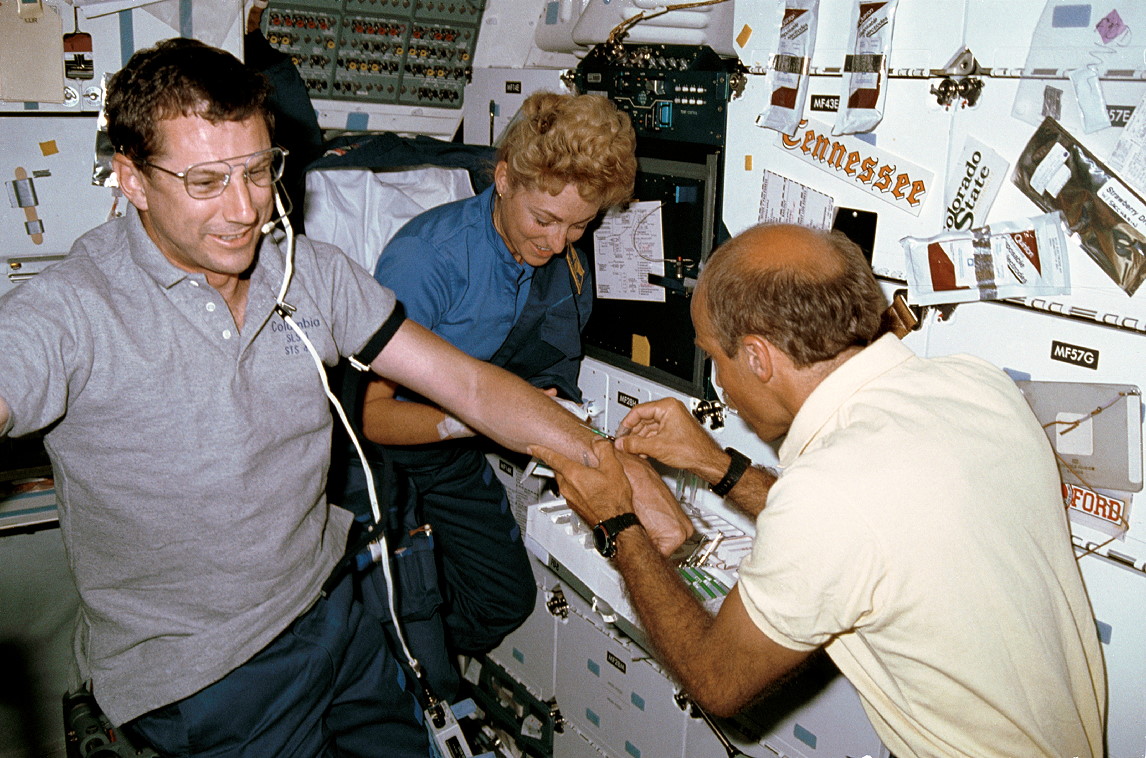One Man and His Catheter: 25 Years Since the Shuttle's First Life Sciences Mission (Part 2)By Ben Evans, on June 12th, 2016
 Having ridden to orbit wearing a heart catheter, Drew Gaffney (left) offers his arm to Jim Bagian and Millie Hughes-Fulford for one of many blood draws. Photo Credit: NASA, via Joachim Becker/SpaceFacts.de
Having ridden to orbit wearing a heart catheter, Drew Gaffney (left) offers his arm to Jim Bagian and Millie Hughes-Fulford for one of many blood draws. Photo Credit: NASA, via Joachim Becker/SpaceFacts.deA quarter-century ago, this week, one of the most complex scientific research missions ever undertaken rocketed into orbit aboard Space Shuttle Columbia. The first Spacelab Life Sciences (SLS-1) flight—utilizing the bus-sized Spacelab module in the shuttle’s payload bay—
was the first mission totally dedicated to the life sciences. And the STS-40 crew, including a pair of physicians, a cardiologist, and a biochemist, also marked the first time in history that three women had flown together on the same mission.
Originally scheduled to take place in early 1986, prior to the Challenger tragedy, it was extensively postponed in the aftermath of the disaster and wound up flying in June 1991. By then, its crew complement had changed markedly. Physiologist Bob Phillips, who should have been one of the two Payload Specialists on SLS-1, was grounded by a medical issue and replaced, whilst the tragic death of another astronaut led to the replacement of STS-40’s original pilot, John Blaha, with Sid Gutierrez.
The “science team” of physicians Jim Bagian and Rhea Seddon, cardiologist Drew Gaffney, and biochemist Millie Hughes-Fulford would be largely responsible for the research work during the nine-day mission. However, the “orbiter team” of Commander Bryan O’Connor and crewmates Gutierrez—the first and only Hispanic-born shuttle pilot—and Tammy Jernigan had shown willingness to participate as “guinea pigs” for blood draws and other experiments. “Tammy Jernigan had already signed up for everything,” O’Connor recalled in his NASA oral history. “She was a scientist herself and certainly was interested and very engaged in the training.” For O’Connor and Gutierrez, as STS-40’s pilots, it was more difficult. Much of their training revolved around landing the shuttle and, although they accepted some experiment duties, they rejected those which posed a risk to their flying abilities, such as those which focused on the eyes or the vestibular system. (...)
Unlike most Spacelab flights, whose crews broke into two halves to work around the clock, STS-40 operated on a “single-shift” timeline. That said, the seven astronauts typically worked 14-hour days, with close measurements of their circadian rhythms to provide uniformity of biomedical data points. The 18 experiments aboard SLS-1 explored the fundamental problems affecting the biology of humans—including the heart, blood vessels, lungs, kidneys, and hormone-secreting glands—as well as animals and fish in microgravity. Ten experiments used the astronauts, whilst seven others focused on 28 rats and another utilized almost 2,500 jellyfish. Researchers from France, Russia, Germany, and Canada participated in SLS-1, through a biospecimen-sharing project. (...)
As they worked, the science crew of Bagian, Seddon, Gaffney, and Hughes-Fulford literally regarded SLS-1 as their “home” for most of the flight … for they elected to sleep aboard the Spacelab module, too. “They all thought it was a great place to sleep,” O’Connor told Mission Control on one occasion. “It was nice and dark and quiet back there,” agreed Seddon. “We were doing single shifts, so the lab was essentially buttoned up for the night. It was dark and we could cool it down, so we just hung our hammocks back there.” Every so often, the quiet would be disturbed. The Spacelab was situated near the end of the payload bay, so the science crew could hear the
boom boom boom of Columbia’s thrusters, as well as the mice in their cages and the refrigerators switching on and off. However, Seddon regarded it as a far more peaceful place to relax than the flight deck or middeck. (...)
In addition to humans and rodents,
SLS-1 marked the first-ever flight of jellyfish aboard the shuttle. All told, 2,478 Moon jellyfish—one of the simplest organisms known to possess a nervous system—were housed in Columbia’s middeck and were being flown to examine their reproductive abilities and swimming behavior in microgravity. The jellyfish polyps, which developed into sexually reproductive ephyrae in space, proved “normal” in most respects, despite hormonal changes and swimming abnormalities after landing. (...)
For the first time, an airport-style “people mover,” known as the Crew Transport Vehicle (CTV), was employed to remove the seven astronauts from the shuttle. It allowed them to doff their bulky pressure suits, regain their “land legs,” and subject themselves to the doctors for medical checks. For Millie Hughes-Fulford, the landing produced peculiar sensations. The position of the shuttle’s nose on the runway meant that the entire cabin was angled slightly downward, and she found it hard to get out of her seat and stand up. After removing her suit in the CTV, she finally had the chance to walk down the steps to see her husband and daughter. “Because my equilibrium was totally gone,” she told an interviewer from the Smithsonian, years later, “I was holding onto the rail, trying to move as quickly as possible and not walk like a little old lady.”
When her daughter arrived, Hughes-Fulford gave her a hug and whispered in her ear: “
Help hold me up!”
https://www.americaspace.com/2016/06/12/one-man-and-his-catheter-25-years-since-the-shuttles-first-life-sciences-mission-part-2/